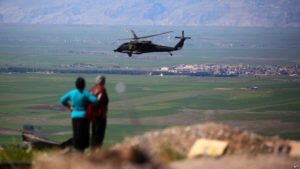Special to WorldTribune.com
Radio Free Europe / Radio Liberty
A Russian diplomat has emphasized that safe zones that would be established in Syria under a deal reached by Russia, Turkey, and Iran would be closed to warplanes of the U.S.-led coalition.
Russia’s chef representative at peace talks in Kazakhstan sponsored by those countries, Aleksandr Lavrentyev, spoke in the Kazakh capital, Astana, on May 5, a day after the memorandum was signed.

“In the de-escalation zones, aviation operations — especially by the forces of the international coalition forces — are absolutely not envisaged, with or without prior notification,” he said. “This question is closed.”
The plan endorsed by Russia, Turkey and Iran calls for a ban on all overflights, but Lavrentyev spoke in response to a question posed by a Russian news agency about U.S.-led coalition aircraft.
Separate air-strike campaigns by Russia and the United States have caused tension in the past two years.
On May 4, Lavrentyev told reporters that the agreement would go into effect on May 6 and that Syrian government warplanes were expected to avoid the protected zones unless rebel groups carried out attacks.
Armed opposition members said that in the past such exceptions have enabled Russian-backed government forces to strike anywhere and say they are hitting terrorists.
The United States reacted cautiously to the agreement, saying that it “supports any effort that can genuinely de-escalate the violence in Syria” but expressing concern about Iran’s role and saying Russia must ensure compliance by the Syrian government.
UN Secretary-General Antonio Guterres cautiously welcomed the agreement on May 4, but suggested it was important to see results on the ground.
Guterres “is encouraged by the agreement…to de-escalate violence in key areas in Syria,” his spokesman, Stephane Dujarric, said in a statement on May 4.
“It will be crucial to see this agreement actually improve the lives of Syrians,” he added.
Within safe zones that are be set up by June 4, the memorandum signed at peace talks in Astana, Kazakhstan, provides for a cease-fire, a ban on all overflights, rapid deliveries of humanitarian aid to the designated areas, and the return of refugees.
Guterres “welcomes the commitments to ceasing the use of all weapons, particularly aerial assets” and to quickly delivering medical aid and basic necessities, Dujarric said.
“The commitments made should not affect the rights of Syrians to seek and enjoy asylum,” he added — an apparent reference to concerns that one of the aims of plans for safe zones is to discourage refugees.
The safe-zone pact was opposed by Syrian armed opposition groups, which among other things objected to the involvement of Iran — a concern echoed by the United States.
The United States “supports any effort that can genuinely de-escalate the violence in Syria, ensure unhindered humanitarian access, focus energies on the defeat of ISIS and other terrorists, and create the conditions for a credible political resolution of the conflict,” State Department spokeswoman Heather Nauert said in a statement on May 4.
However, she said: “We continue to have concerns about the Astana agreement, including the involvement of Iran as a so-called ‘guarantor.’ Iran’s activities in Syria have only contributed to the violence, not stopped it, and Iran’s unquestioning support for the Assad regime has perpetuated the misery of ordinary Syrians.”
“In light of the failures of past agreements, we have reason to be cautious. We expect the regime to stop all attacks on civilians and opposition forces, something they have never done. We expect Russia to ensure…compliance” by Syrian President Bashar al-Assad’s government, she said.
The memorandum calls for setting up four “de-escalation zones” in northern, central, and southern Syria, where Assad’s forces are fighting rebels in a war that has killed some 400,000 people since 2011.
The safe zones were originally proposed by Russia, which has given Assad major military and diplomatic support throughout the conflict. Iran has also backed Assad and helped his forces fight opponents.
Russian President Vladimir Putin discussed the safe-zone proposal with U.S. President Donald Trump in a May 2 telephone call that focused on Syria.
A White House statement said the conversation was “very good” and “included the discussion of safe, or de-escalation, zones to achieve lasting peace for humanitarian and many other reasons.”
But Trump has not spoken publicly about the Russian proposal or the memorandum signed by Russia, Turkey, and Iran.
They would be surrounded by checkpoints manned by opposition and government troops.
Foreign troops also could be deployed in observer roles.
